Abstract
Pseudomonas aeruginosa-mediated suppression of the immune response to Listeria monocytogenes was investigated in mice. Because delayed-type hypersensitivity (DTH) footpad swelling to L. monocytogenes was suppressed equally in lipopolysaccharide-responsive and -hyporesponsive mouse strains, the lipopolysaccharide component of P. aeruginosa could not have been the suppressive agent. Mucoid P. aeruginosa cells were no more suppressive than their nonmucoid revertants; therefore, mucoid coating was not an additional immunosuppressive element. Interleukin-1 and macrophage inhibitory factor production to L. monocytogenes and clearance of L. monocytogenes from mouse spleens were all decreased by prior Pseudomonas infection, indicating that cell-mediated immunity, as well as DTH, was decreased to a sublethal Listeria dose. The timing of Pseudomonas exposure relative to Listeria sensitization was varied. P. aeruginosa injected 24 or 6 h before or at the same time as L. monocytogenes depressed DTH to Listeria challenge 7 days later. Animals treated in this way could not respond to reinfection with L. monocytogenes at 13 days. P. aeruginosa administered to L. monocytogenes-sensitized mice at the time of footpad challenge was suppressive, but these mice responded normally upon reinfection. It appears that P. aeruginosa induced two types of suppression to L. monocytogenes: a transient suppression, affecting DTH challenge but not resensitization, and a longer lasting suppression that did not permit mice exposed to P. aeruginosa at the time of Listeria sensitization to respond to subsequent Listeria exposure.
Full text
PDF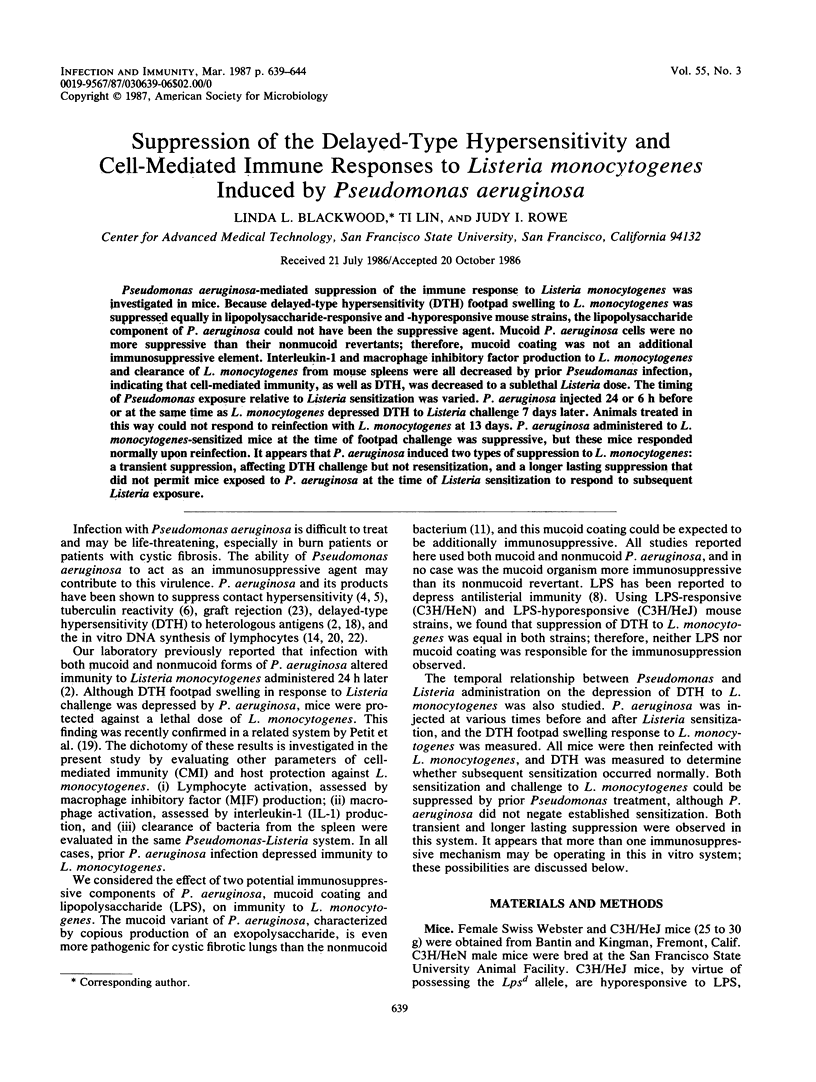
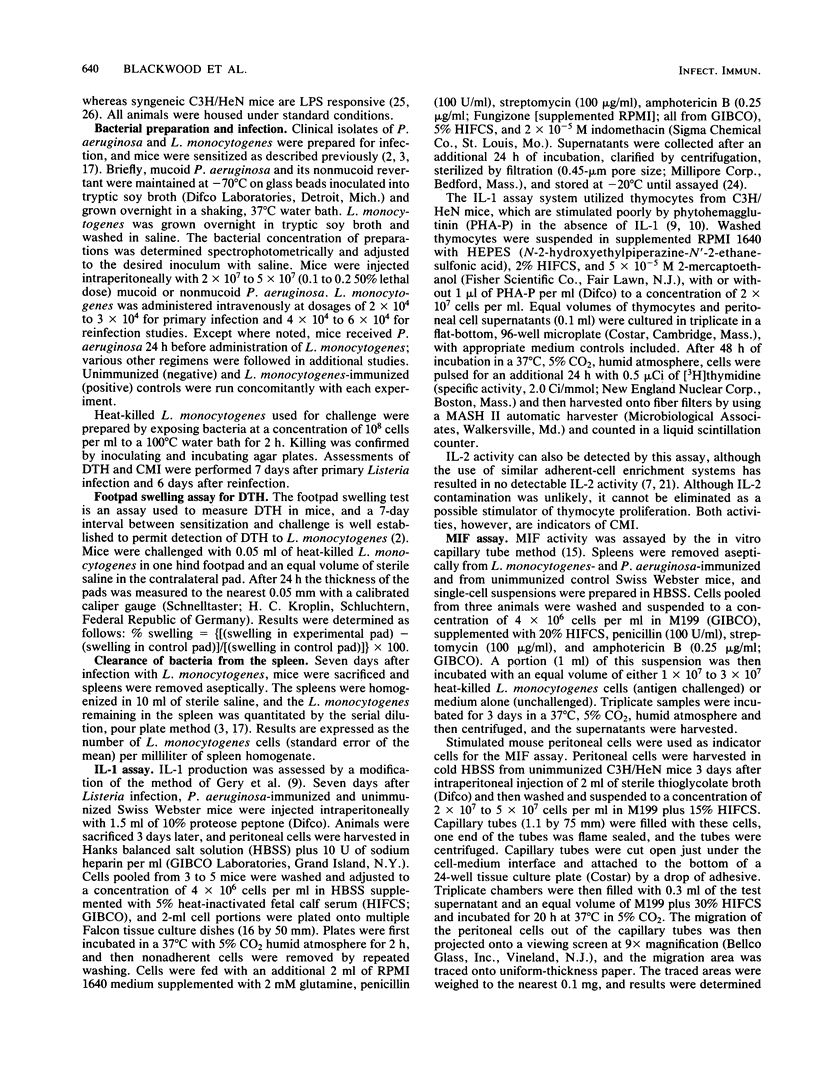
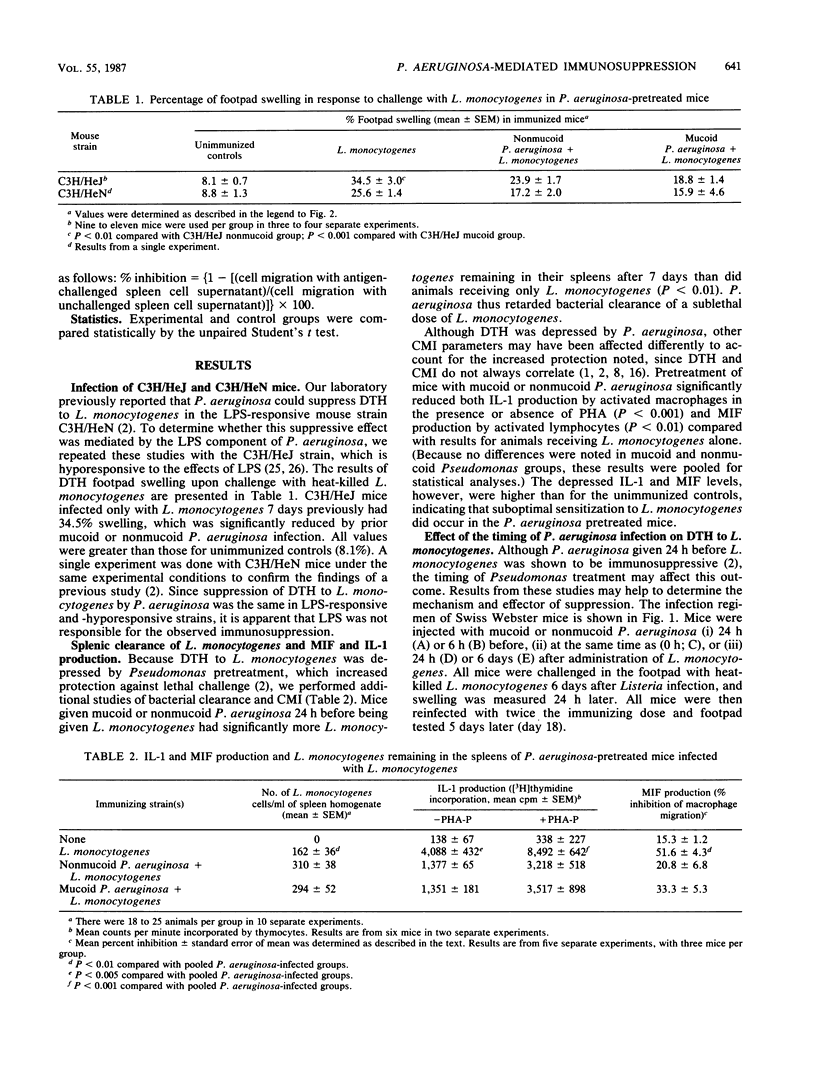
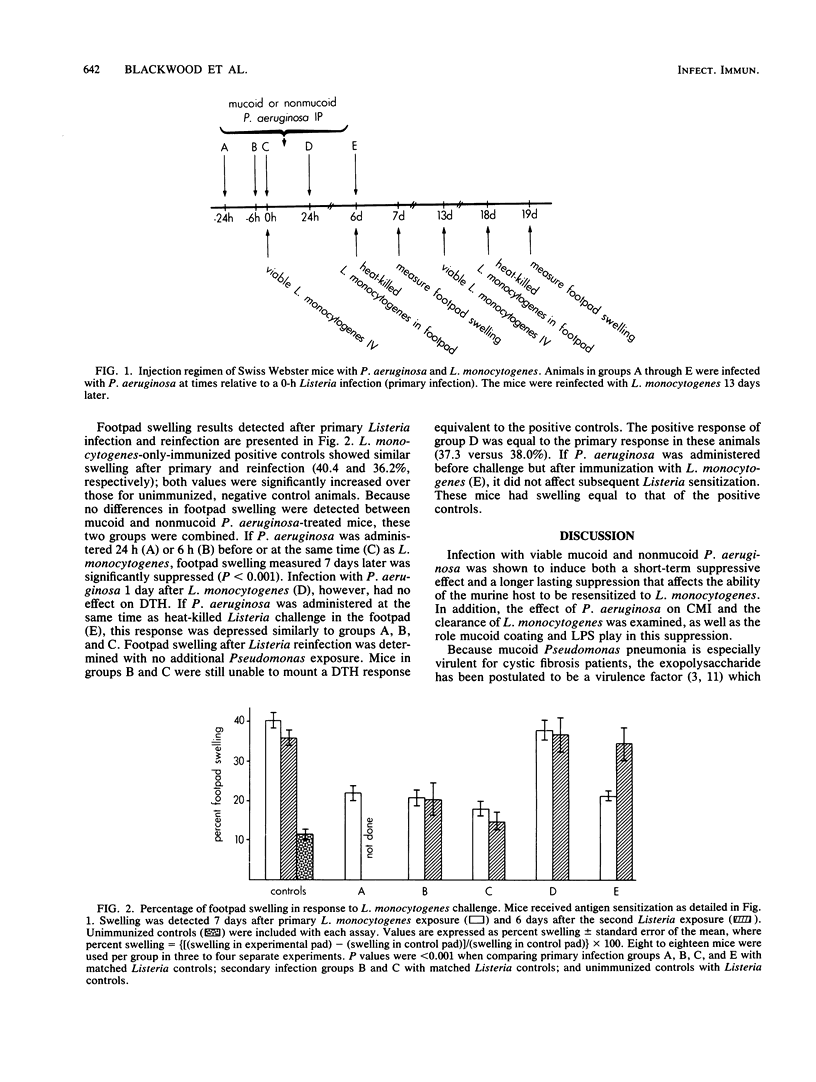
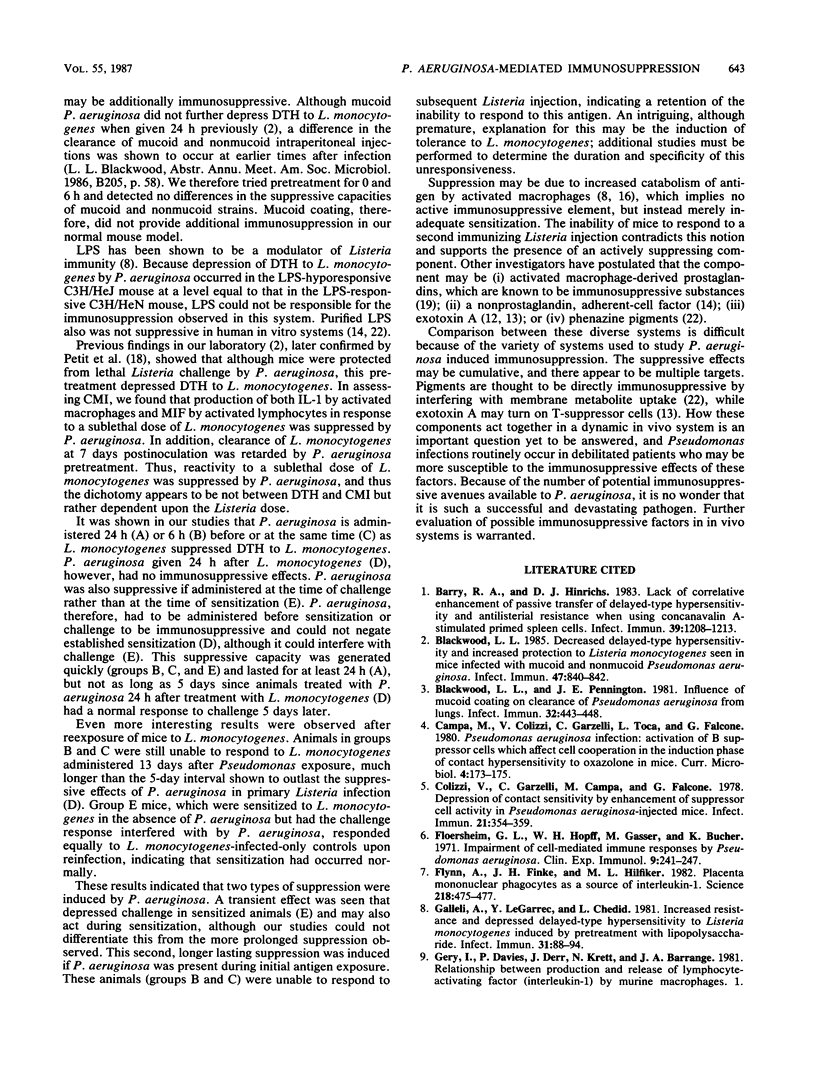
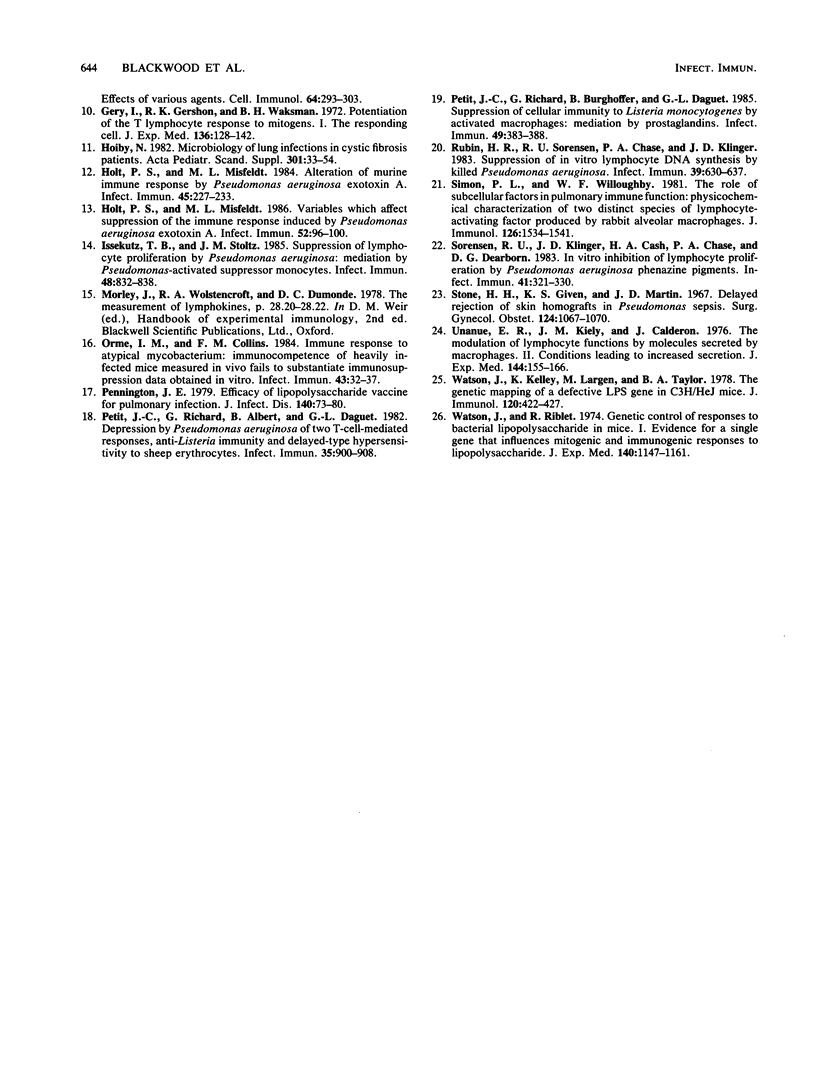
Selected References
These references are in PubMed. This may not be the complete list of references from this article.
- Barry R. A., Hinrichs D. J. Lack of correlative enhancement of passive transfer of delayed-type hypersensitivity and antilisterial resistance when using concanavalin A-stimulated primed spleen cells. Infect Immun. 1983 Mar;39(3):1208–1213. doi: 10.1128/iai.39.3.1208-1213.1983. [DOI] [PMC free article] [PubMed] [Google Scholar]
- Blackwood L. L. Decreased delayed-type hypersensitivity and increased protection to Listeria monocytogenes seen in mice infected with mucoid and nonmucoid Pseudomonas aeruginosa. Infect Immun. 1985 Mar;47(3):840–842. doi: 10.1128/iai.47.3.840-842.1985. [DOI] [PMC free article] [PubMed] [Google Scholar]
- Blackwood L. L., Pennington J. E. Influence of mucoid coating on clearance of Pseudomonas aeruginosa from lungs. Infect Immun. 1981 May;32(2):443–448. doi: 10.1128/iai.32.2.443-448.1981. [DOI] [PMC free article] [PubMed] [Google Scholar]
- Colizzi V., Garzelli C., Campa M., Falcone G. Depression of contact sensitivity by enhancement of suppressor cell activity in Pseudomonas aeruginosa-injected mice. Infect Immun. 1978 Aug;21(2):354–359. doi: 10.1128/iai.21.2.354-359.1978. [DOI] [PMC free article] [PubMed] [Google Scholar]
- Floersheim G. L., Hopff W. H., Gasser M., Bucher K. Impairment of cell-mediated immune responses by Pseudomonas aeruginosa. Clin Exp Immunol. 1971 Aug;9(2):241–247. [PMC free article] [PubMed] [Google Scholar]
- Flynn A., Finke J. H., Hilfiker M. L. Placental mononuclear phagocytes as a source of interleukin-1. Science. 1982 Oct 29;218(4571):475–477. doi: 10.1126/science.6981846. [DOI] [PubMed] [Google Scholar]
- Galleli A., Le Garrec Y., Chedid L. Increased resistance and depressed delayed-type hypersensitivity to Listeria monocytogenes induced by pretreatment with lipopolysaccharide. Infect Immun. 1981 Jan;31(1):88–94. doi: 10.1128/iai.31.1.88-94.1981. [DOI] [PMC free article] [PubMed] [Google Scholar]
- Gery I., Gershon R. K., Waksman B. H. Potentiation of the T-lymphocyte response to mitogens. I. The responding cell. J Exp Med. 1972 Jul 1;136(1):128–142. doi: 10.1084/jem.136.1.128. [DOI] [PMC free article] [PubMed] [Google Scholar]
- Holt P. S., Misfeldt M. L. Alteration of murine immune response by Pseudomonas aeruginosa exotoxin A. Infect Immun. 1984 Jul;45(1):227–233. doi: 10.1128/iai.45.1.227-233.1984. [DOI] [PMC free article] [PubMed] [Google Scholar]
- Holt P. S., Misfeldt M. L. Variables which affect suppression of the immune response induced by Pseudomonas aeruginosa exotoxin A. Infect Immun. 1986 Apr;52(1):96–100. doi: 10.1128/iai.52.1.96-100.1986. [DOI] [PMC free article] [PubMed] [Google Scholar]
- Issekutz T. B., Stoltz J. M. Suppression of lymphocyte proliferation by Pseudomonas aeruginosa: mediation by Pseudomonas-activated suppressor monocytes. Infect Immun. 1985 Jun;48(3):832–838. doi: 10.1128/iai.48.3.832-838.1985. [DOI] [PMC free article] [PubMed] [Google Scholar]
- Orme I. M., Collins F. M. Immune response to atypical mycobacteria: immunocompetence of heavily infected mice measured in vivo fails to substantiate immunosuppression data obtained in vitro. Infect Immun. 1984 Jan;43(1):32–37. doi: 10.1128/iai.43.1.32-37.1984. [DOI] [PMC free article] [PubMed] [Google Scholar]
- Pennington J. E. Lipopolysaccharide pseudomonas vaccine: efficacy against pulmonary infection with Pseudomonas aeruginosa. J Infect Dis. 1979 Jul;140(1):73–80. doi: 10.1093/infdis/140.1.73. [DOI] [PubMed] [Google Scholar]
- Petit J. C., Richard G., Albert B., Daguet G. L. Depression by Pseudomonas aeruginosa of two T-cell-mediated responses, anti-Listeria immunity and delayed-type hypersensitivity to sheep erythrocytes. Infect Immun. 1982 Mar;35(3):900–908. doi: 10.1128/iai.35.3.900-908.1982. [DOI] [PMC free article] [PubMed] [Google Scholar]
- Petit J. C., Richard G., Burghoffer B., Daguet G. L. Suppression of cellular immunity to Listeria monocytogenes by activated macrophages: mediation by prostaglandins. Infect Immun. 1985 Aug;49(2):383–388. doi: 10.1128/iai.49.2.383-388.1985. [DOI] [PMC free article] [PubMed] [Google Scholar]
- Rubin H. R., Sorensen R. U., Chase P. A., Klinger J. D. Suppression of in vitro lymphocyte DNA synthesis by killed Pseudomonas aeruginosa. Infect Immun. 1983 Feb;39(2):630–637. doi: 10.1128/iai.39.2.630-637.1983. [DOI] [PMC free article] [PubMed] [Google Scholar]
- Simon P. L., Willoughby W. F. The role of subcellular factors in pulmonary immune function: physicochemical characterization of two distinct species of lymphocyte-activating factor produced by rabbit alveolar macrophages. J Immunol. 1981 Apr;126(4):1534–1541. [PubMed] [Google Scholar]
- Sorensen R. U., Klinger J. D., Cash H. A., Chase P. A., Dearborn D. G. In vitro inhibition of lymphocyte proliferation by Pseudomonas aeruginosa phenazine pigments. Infect Immun. 1983 Jul;41(1):321–330. doi: 10.1128/iai.41.1.321-330.1983. [DOI] [PMC free article] [PubMed] [Google Scholar]
- Stone H. H., Given K. S., Martin J. D., Jr Delayed rejection of skin homografts in Pseudomonas sepsis. Surg Gynecol Obstet. 1967 May;124(5):1067–1070. [PubMed] [Google Scholar]
- Unanue E. R., Kiely J. M., Calderon J. The modulation of lymphocyte functions by molecules secreted by macrophages. II. Conditions leading to increased secretion. J Exp Med. 1976 Jul 1;144(1):155–166. doi: 10.1084/jem.144.1.155. [DOI] [PMC free article] [PubMed] [Google Scholar]
- Watson J., Kelly K., Largen M., Taylor B. A. The genetic mapping of a defective LPS response gene in C3H/HeJ mice. J Immunol. 1978 Feb;120(2):422–424. [PubMed] [Google Scholar]
- Watson J., Riblet R. Genetic control of responses to bacterial lipopolysaccharides in mice. I. Evidence for a single gene that influences mitogenic and immunogenic respones to lipopolysaccharides. J Exp Med. 1974 Nov 1;140(5):1147–1161. doi: 10.1084/jem.140.5.1147. [DOI] [PMC free article] [PubMed] [Google Scholar]


